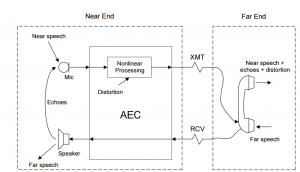Home > BLOG CENTER > AEC in hands-free conference systems
Home > BLOG CENTER > AEC in hands-free conference systems
Acoustic echo cancellers (AEC) greatly enhance the audio quality of a multipoint hands-free communications system. They allow conferences to progress more smoothly and naturally, keep the participants more comfortable, and prevent listener fatigue. An AEC solution that is poorly designed or inappropriate for the location will not provide these benefits and can even degrade audio quality significantly.
Acoustic echo cancellation is useful in any hands-free telecommunications situation involving two or more locations. Acoustic echo is most noticeable (and annoying) when delay is present in the transmission path. This would happen primarily in long distance circuits, or systems utilizing speech compression (such as in videoconferencing or digital cellular phones). Even though this echo might not be as annoying when there is no delay (such as with short links between conference rooms in the same building or distance learning over fiber-optic cable), room acoustics will still affect the sound and may hamper communication. Also, howling can occur if the microphone is positioned too close to the speaker whether or not there is transmission delay, and is eliminated by most acoustic echo cancellers.
Acoustic echo cancellers can be used in both narrow band (3.5 kHz) and wide-band (7 kHz) conferencing systems. Narrow band applications include teleconferencing and low bit-rate video conferencing. Wideband applications include high quality teleconferencing and videoconferencing, as well as distance learning. Users of wide-band conferencing systems should be particularly interested in using acoustic echo cancellation, as it would allow them to make the most out of the additional audio capabilities of their systems.
The primary beneficiaries of an echo canceller are the people at the far (or remote) end of the transmission path. The near (or local) echo canceller prevents the echo of the remote peoples’ voices from being returned (i.e. echoed) to them through the audio system. People speaking on the same (local) end as the AEC should not notice the AEC if it is doing its job properly. While the people on the far end receive the benefit of better audio quality, it also enables the conversation to flow more smoothly, benefiting both parties.

Illustration of the effects of AEC operation and room acoustics on the transmitted speech. The far speech that travels through the receive path is not modified as it passes through the AEC. In an echo canceller that is poorly designed, there may be residual echoes as well as distortion added to the near speech signal (these effects are described in detail later). This degrades the speech that is transmitted, so that the poor audio quality is noticed on the far end.
Acoustic echo cancellers, AEC, communications system, Conference Systems, teleconferencing
Note: If not otherwise specified, are good article would Technologies original, reproduced please specify from http://www.meeteasy.com.hk/2017/04/12/aec-in-hands-free-conference-systems/.40088 41166info@meeteasy.com.hk
3/F,Building#10, Jiu Xiang Ling Industrial Zone,Xili
Nanshan District, Shenzhen, 518055, China